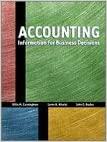In this chapter, we described how investors and creditors obtain information about publicly held corporations, and we
Question:
In this chapter, we described how investors and creditors obtain information about publicly held corporations, and we began our coverage of the stockholders’ equity section of a corporation’s balance sheet and a corporation’s income statement. Read the following item that appeared on May I6 of a recent year, on the first page of the Money section of USA Today:
TOY SALES: The world’s largest toy retailer, hurt by weak video game sales, said [yesterday] that its first-quarter net income slipped 51%. Toys “R” Us net income fell to $18.4 million, or 7 cents a share, from $37.58 million, or 13 cents a share, a year earlier. Revenue was up slightly, at $1.49 billion, compared with $1.46 billion in the year-ago quarter. Revenue for stores open at least a year fell 10%. Toys “R” Us stock dropped | 1/8 to $26 in heavy trading. The company has 618 toy stores in the USA, 300 international toy stores and 206 Kids “R” Us children’s clothing stores.
Required: Respond to the following questions:
(1) In what month does the annual accounting period for Toys “R” Us end? How did you figure that out? Why would Toys “R” Us end its accounting period then?
(2) How many shares of stock do you think are owned by Toys “R” Us investors at the end of the first quarter of the year? How did you calculate that number?
(3) What was the market value of Toys “R” Us stock on the morning of May 15? What about on the morning of May 16? Explain why you think this change occurred.
(4) Assume you had purchased 500 shares of Toys “R” Us stock on May [5 of the previous year for $24 a share. How would you evaluate your investment’s performance?
As an investor, what specific information in the newspaper item would concern you the most? Why? TK-1
Step by Step Answer:

Accounting Information For Business Decisions
ISBN: 9780030224294
1st Edition
Authors: Billie Cunningham, Loren A. Nikolai, John Bazley





